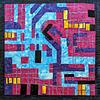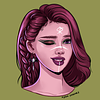Take a photo of a barcode or cover
This was a good book and I look forward to reading the sequel. While it's clearly a young adult fantasy series, I feel like there are more adult stories lurking behind in the author's imagination. Obviously, the world-building was incredible, but I didn't really feel a need to read the detailed appendix at the end of the book. It's not that the world doesn't compel me, but I would rather read more stories instead.
Monster Blood Tattoo creates an interesting world that still suffers a bit from "first-book" syndrome: not enough happens in this first installment! However, it's great to see such an original fantastic realm--home to monsters that are more of the under the bed variety than dragons and elves.
well written and satisfying. i cared about all the characters in one way or another, and that's the most i can ask for in a fantasy. pretty sure this is YA since there's no sex and the violence isn't too graphic. it has a shy kid who's not good at anything but wants a life of adventure on the high seas but who takes what he gets.
Reread, 2020: I like this more and less on reread. It's so steampunk, retaining the class criticism, substituting monster-hunting ethics for imperialism/racism with something approximating grace, and delighting in material detail as avenue to worldbuilding. The plot and characters feel more MG than YA, particularly because the major twist is so obvious. But there's something charming in the way that heavy foreshadowing and chunky caricatures cross with class/race/boundary relations--it's not high art, but it's effective and even affecting. Or, in other words: Europe is great.
Original review, 2008: Rossamünd Bookchild is a foundling boy with an unfortunate name, about to leave his orphanage for employment out in the wide world. But Rossamünd lives in the Half-Continent, a place with its own lexicon and styles, populated both by men and by monsters who haunt the countryside and oceans and wage an never-ending war with mankind. Bright action, vivid characters and illustrations, and a(n overly) lengthy appendix set this book apart: at once comically larger than life and carefully constructed with plenty of ambiguous detail, Foundling could benefit from less world building but remains an intriguing, readable novel which reads fairly well on its own and promises an exciting adventure in the sequels to come. I recommend it to all readers, and I look forward to the rest of the series.
Foundling is not an exceptional book--perhaps as a nature of its premise (which focuses so heavily on world-building), perhaps because it is the first in a series (and Rossamünd has yet to undergo significant growth). There is nothing earthshaking, no marvelous and eye-opening developments, no significant or long-lasting impact on the reader. But even if it is not great, Foundling is readable, engaging, and vivid—on the whole, quite good. The characters are colorful and humorously faulted, and the author's own illustrations help bring them to life. The plot is a rambling journey across a dangerous countryside, constantly introducing new monsters and new characters to engage the reader. The setting is complex, filled with its own language, species, fashion, and society. Best of all, everything has the potential to be ambigious, including local dialects, complex and secretive character motivation, and above all the nature of monsters—who are perhaps not so entirely evil as Rossamünd initially believes.
With all this ambiguity, an 120 page appendix, and a few too many nouns in the Half-Content's language, Foundling does suffer a little from a glut of complexity. Cornish is enamored with his own fantasy world, which drags reader attention away from character and plot—sometimes to learn something no more important than the layout of a boat. Luckily, there only a little unnecessary world building, but it would be nice to see the background integrated with a bit more subtlety. Otherwise, this book is quite enjoyable. It's a rare occasion when I pick up a fantasy book series, but Foundling is a fun story set within a vivid world which makes for a swift, engrossing read. The book has a fairly satisfying conclusion while still creating a promising beginning to the Monster Blood Tattoo series, which is the best of both worlds. I enjoyed it, and look forward to the sequels; I also recommend it to all readers--younger readers will find the text approachable while older readers still find it engaging, and the Half-Continent's complexity opens up a new world for any audience.
Original review, 2008: Rossamünd Bookchild is a foundling boy with an unfortunate name, about to leave his orphanage for employment out in the wide world. But Rossamünd lives in the Half-Continent, a place with its own lexicon and styles, populated both by men and by monsters who haunt the countryside and oceans and wage an never-ending war with mankind. Bright action, vivid characters and illustrations, and a(n overly) lengthy appendix set this book apart: at once comically larger than life and carefully constructed with plenty of ambiguous detail, Foundling could benefit from less world building but remains an intriguing, readable novel which reads fairly well on its own and promises an exciting adventure in the sequels to come. I recommend it to all readers, and I look forward to the rest of the series.
Foundling is not an exceptional book--perhaps as a nature of its premise (which focuses so heavily on world-building), perhaps because it is the first in a series (and Rossamünd has yet to undergo significant growth). There is nothing earthshaking, no marvelous and eye-opening developments, no significant or long-lasting impact on the reader. But even if it is not great, Foundling is readable, engaging, and vivid—on the whole, quite good. The characters are colorful and humorously faulted, and the author's own illustrations help bring them to life. The plot is a rambling journey across a dangerous countryside, constantly introducing new monsters and new characters to engage the reader. The setting is complex, filled with its own language, species, fashion, and society. Best of all, everything has the potential to be ambigious, including local dialects, complex and secretive character motivation, and above all the nature of monsters—who are perhaps not so entirely evil as Rossamünd initially believes.
With all this ambiguity, an 120 page appendix, and a few too many nouns in the Half-Content's language, Foundling does suffer a little from a glut of complexity. Cornish is enamored with his own fantasy world, which drags reader attention away from character and plot—sometimes to learn something no more important than the layout of a boat. Luckily, there only a little unnecessary world building, but it would be nice to see the background integrated with a bit more subtlety. Otherwise, this book is quite enjoyable. It's a rare occasion when I pick up a fantasy book series, but Foundling is a fun story set within a vivid world which makes for a swift, engrossing read. The book has a fairly satisfying conclusion while still creating a promising beginning to the Monster Blood Tattoo series, which is the best of both worlds. I enjoyed it, and look forward to the sequels; I also recommend it to all readers--younger readers will find the text approachable while older readers still find it engaging, and the Half-Continent's complexity opens up a new world for any audience.
I adore D.M. Cornish's The Foundling's Tale (formerly known as Monster's Blood Tattoo) series, which includes the books Foundling, Lamplighter and Factotum. It has oft-been described as Dickens-like tale of an orphan's through through an 18th-century-like, biopunk world...with monsters.
Biopunk? Think steampunk. But instead of gears, steam, and blimps...technology based on plants, vat-grown tissue, surgical enhancements, and potions.
There is so much I loved about these books. And much is hard to put into words. One thing was it's texture. And by that, I not only mean the objects, surfaces in this world, but the institutions, culture, language, and tech. It just feels, sounds, and looks good in my mind. Though the plot is great, for me, it's really the world that Cornish has created that enchanted me. It is so thick with potential that I hope he either writes a hundred books, or finds a way to expand it to other writers and creative platforms, as has been done with Star Trek, Star Wars, D&D, etc.
This book is perfect if you like....
TECH: If you like clockpunk, steampunk, or cyber punk. Tech is tech.
MINUTIAE: If you like reading all the little text in a Chris Ware graphic novel or a Dave Eggars' early McSweeney's issues. His books include a massive, mostly-for-fun glossary and gorgeous, detailed illustrations...by the author!
MADE UP WORDS: Did you enjoy all the whimsical names J.K. Rowling invented for her Potter universe? These books have a TON!
DESIGN: These books just look and feel wonderful. The size and proportion of a 19th-century novel. Beautiful covers with sublime color palettes and delicious paper stock.
18TH & 19TH CENTURIES: Like I said, think Dickens. Also, the movies Amadeus, Immortal Beloved, and Glory. Or the books Bartleby the Scrivener and Frankenstein. Lots of bookkeeping done in ledgers. Powdered wigs, tricornered hats, muskets and pale-faced bureaucrats.
MONSTERS: Of course.
Biopunk? Think steampunk. But instead of gears, steam, and blimps...technology based on plants, vat-grown tissue, surgical enhancements, and potions.
There is so much I loved about these books. And much is hard to put into words. One thing was it's texture. And by that, I not only mean the objects, surfaces in this world, but the institutions, culture, language, and tech. It just feels, sounds, and looks good in my mind. Though the plot is great, for me, it's really the world that Cornish has created that enchanted me. It is so thick with potential that I hope he either writes a hundred books, or finds a way to expand it to other writers and creative platforms, as has been done with Star Trek, Star Wars, D&D, etc.
This book is perfect if you like....
TECH: If you like clockpunk, steampunk, or cyber punk. Tech is tech.
MINUTIAE: If you like reading all the little text in a Chris Ware graphic novel or a Dave Eggars' early McSweeney's issues. His books include a massive, mostly-for-fun glossary and gorgeous, detailed illustrations...by the author!
MADE UP WORDS: Did you enjoy all the whimsical names J.K. Rowling invented for her Potter universe? These books have a TON!
DESIGN: These books just look and feel wonderful. The size and proportion of a 19th-century novel. Beautiful covers with sublime color palettes and delicious paper stock.
18TH & 19TH CENTURIES: Like I said, think Dickens. Also, the movies Amadeus, Immortal Beloved, and Glory. Or the books Bartleby the Scrivener and Frankenstein. Lots of bookkeeping done in ledgers. Powdered wigs, tricornered hats, muskets and pale-faced bureaucrats.
MONSTERS: Of course.
A thoroughly entertaining fantasy and an intriguing example of world-building. I love Cornish's inventive and at times playful use of language, and Rossamund is an engaging protagonist.
Looking forward to the next installation.
Looking forward to the next installation.
The amount of thought and work that went into this book is incredible. The world-building is a major accomplishment, and I enjoyed the style of the author's prose.
I just can't get over the fact that the major turning point in the beginning of the story relies on the main character not being able to count to five.
I ordered book two and am looking forward to it!
I just can't get over the fact that the major turning point in the beginning of the story relies on the main character not being able to count to five.
I ordered book two and am looking forward to it!
adventurous
emotional
mysterious
fast-paced
Plot or Character Driven:
Plot
Strong character development:
Yes
Loveable characters:
Yes
Diverse cast of characters:
No
Flaws of characters a main focus:
No
I'll admit, I picked this up because the series name sounded cool. Reading it and learning about the world was fascinating, and Rossamünd was a lovable young adventurer setting out on his first journey. I'm excited to see where it goes next, and i recommend this to any young reader who has an itch for a rich new world.
Minor: Animal cruelty, Gun violence, Trafficking, Kidnapping
adventurous
dark
emotional
hopeful
mysterious
reflective
tense
medium-paced
Plot or Character Driven:
Plot
Strong character development:
Yes
Loveable characters:
Yes
Diverse cast of characters:
No
Flaws of characters a main focus:
No
I was so bored with the book, I never even finished it. DON'T PICK IT UP! The saying is so true: Don't judge a book by its cover. It looked interesting to me at first. But I got through a good portion of the book, and nothing had really happened. There was no hook to this story. I need a decent hook that makes me want to know why a certain event is going to take place. Something that makes me say, "Wait, why are they in danger/being suicidal/anything suspenseful. What happened? Who are theyy?" Stuff like that. I don't really want background info at the beginning. It has to be sprinkled throughout the book, and it has to be relevant. Like, okay the orphanage thing was important. But Gosling? Ugh. Boring bully, got that. Move on.






